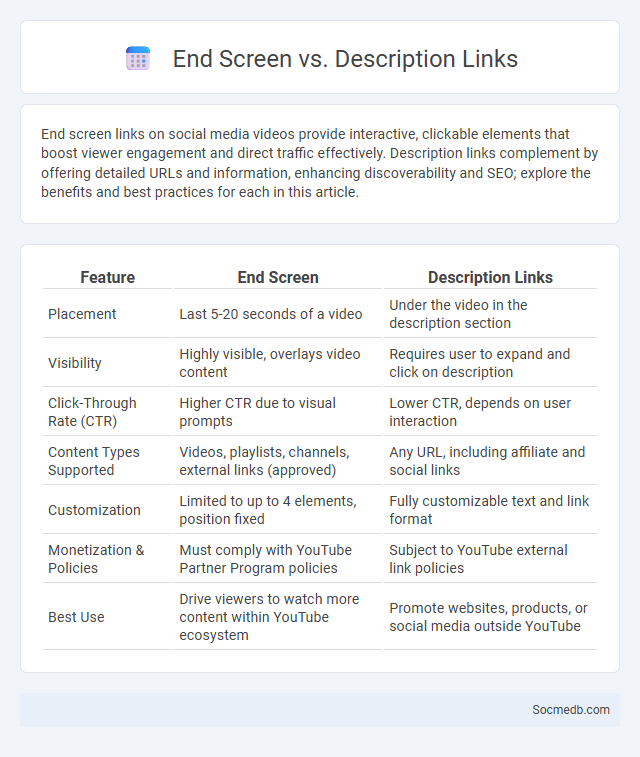
Photo illustration: End screen vs Description links
End screen links on social media videos provide interactive, clickable elements that boost viewer engagement and direct traffic effectively. Description links complement by offering detailed URLs and information, enhancing discoverability and SEO; explore the benefits and best practices for each in this article.
Table of Comparison
| Feature | End Screen | Description Links |
|---|---|---|
| Placement | Last 5-20 seconds of a video | Under the video in the description section |
| Visibility | Highly visible, overlays video content | Requires user to expand and click on description |
| Click-Through Rate (CTR) | Higher CTR due to visual prompts | Lower CTR, depends on user interaction |
| Content Types Supported | Videos, playlists, channels, external links (approved) | Any URL, including affiliate and social links |
| Customization | Limited to up to 4 elements, position fixed | Fully customizable text and link format |
| Monetization & Policies | Must comply with YouTube Partner Program policies | Subject to YouTube external link policies |
| Best Use | Drive viewers to watch more content within YouTube ecosystem | Promote websites, products, or social media outside YouTube |
Understanding End Screens: What Are They?
End screens are interactive elements displayed during the final 5-20 seconds of your social media videos, designed to promote viewer engagement and retention. They typically include clickable buttons for subscribing, watching additional videos, or visiting external links, enhancing your channel growth and content discoverability. Mastering the use of end screens allows you to strategically guide your audience towards desired actions, boosting your social media performance.
Exploring Description Links: Their Role and Impact
Exploring description links on social media reveals how they enhance content accessibility and engagement by providing concise, clickable summaries that attract user attention. These links improve SEO by driving targeted traffic and increasing visibility across platforms, directly influencing your content's reach and interaction rates. Understanding their strategic use helps optimize social media campaigns for better conversion and user experience.
End Screens vs. Description Links: Key Differences
End screens on social media platforms provide visually engaging and interactive elements that prompt viewers to take specific actions like subscribing or watching another video, enhancing user retention and engagement. Description links offer a straightforward way to direct your audience to external websites, resources, or affiliate pages, essential for driving traffic beyond the platform. Understanding the key differences helps you optimize content strategy by combining immediate interactive prompts with detailed resource links.
Placement and Visibility: Which Gets More Clicks?
Social media placement significantly affects visibility and click-through rates, with posts in users' main feeds generally receiving more engagement than stories or sidebar ads. You can increase clicks by strategically timing posts and targeting audiences on platforms like Instagram, Facebook, and LinkedIn where algorithm-driven content placement prioritizes relevance. Optimizing post visuals and copy for each placement ensures maximum visibility and higher interaction rates.
User Engagement: Which Method Performs Better?
Analyzing user engagement metrics across social media platforms reveals that interactive content such as polls, quizzes, and live videos consistently outperforms static posts in generating likes, comments, and shares. Data from platforms like Instagram and Facebook indicate live videos can increase engagement rates by up to 30% compared to traditional photo or text posts. Brands leveraging user-generated content and real-time interaction see enhanced community loyalty and higher conversion rates, establishing these methods as superior for maximizing user engagement.
SEO Implications: End Screens vs Description Links
End screens on social media videos enhance viewer retention by offering direct calls to action, which can improve engagement metrics crucial for SEO rankings. Description links provide searchable metadata and keyword-rich phrases that boost discoverability and drive external traffic to websites. Combining end screens with optimized description links maximizes visibility on platforms and improves overall SEO performance by addressing both user interaction and search algorithm preferences.
Best Practices for Using End Screens
End screens on social media videos should include clear calls-to-action like subscribing, watching another video, or visiting a website to increase engagement effectively. Place end screen elements strategically to avoid overlapping with important visual content, ensuring viewers can easily interact with your prompts. Optimize the timing of end screens by displaying them in the final 5-20 seconds of your video to maximize viewer retention and conversions for your channel.
Optimizing Your Description Links for Maximum Impact
Optimize your description links by incorporating relevant keywords that align with your target audience's search intent, enhancing visibility in social media algorithms. Use concise, clear language and compelling calls-to-action to drive engagement and clicks, ensuring the link complements the overall content message. Employ tracking parameters and URL shorteners to monitor performance and refine strategies for maximum impact across platforms.
Combining End Screens and Description Links Strategically
Combining end screens and description links strategically enhances user engagement by directing viewers to relevant content and increasing click-through rates. You can optimize your social media presence by aligning these elements with targeted keywords and clear calls to action that guide users seamlessly towards desired interactions. This approach maximizes reach and drives higher conversion by integrating interactive features with informative links.
Choosing the Right Approach: Factors to Consider
Choosing the right social media approach involves analyzing target audience demographics, platform algorithms, and content preferences to maximize engagement and reach. Evaluating business goals and available resources ensures the selected strategy aligns with brand identity and marketing objectives. Monitoring competitor activity and industry trends further refines the approach for optimum effectiveness and ROI.
 socmedb.com
socmedb.com